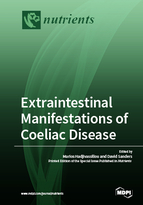Extraintestinal Manifestations of Coeliac Disease
A special issue of Nutrients (ISSN 2072-6643).
Deadline for manuscript submissions: closed (30 September 2018) | Viewed by 180507
Special Issue Editors
Interests: ataxias; neurological manifestations of coeliac disease and gluten sensitivity
Special Issues, Collections and Topics in MDPI journals
Interests: Coeliac Disease
Special Issues, Collections and Topics in MDPI journals
Special Issue Information
Dear Colleagues,
Coeliac Disease (CD) affects at least 1% of the population. “Classical” CD refers to gastrointestinal presentations with anaemia and gastrointestinal symptoms. CD can, however, present with extraintestinal manifestations, the commonest of which are dermatitis herpetiformis and neurological presentations (e.g., ataxia, neuropathy, encephalopathy). Recognition and research into the pathophysiology of such manifestations is likely to enhance our understanding of this complex autoimmune disorder. This Special Issue will concentrate on the latest research into such manifestations, both in clinical terms and also in the pathophysiology of such manifestations, aiming to cover the following areas:
- Dermatitis Herpetiformis
- CD and other autoimmune disorders
- Neurological manifestations (ataxia, peripheral neuropathy, encephalopathy)
- Pathophysiology
- The role of antibodies in the pathophysiology (antigliadin antibodies)
- Transglutaminases (in particular TG3 and TG6)
Prof. David Sanders
Guest Editors
Manuscript Submission Information
Manuscripts should be submitted online at www.mdpi.com by registering and logging in to this website. Once you are registered, click here to go to the submission form. Manuscripts can be submitted until the deadline. All submissions that pass pre-check are peer-reviewed. Accepted papers will be published continuously in the journal (as soon as accepted) and will be listed together on the special issue website. Research articles, review articles as well as short communications are invited. For planned papers, a title and short abstract (about 100 words) can be sent to the Editorial Office for announcement on this website.
Submitted manuscripts should not have been published previously, nor be under consideration for publication elsewhere (except conference proceedings papers). All manuscripts are thoroughly refereed through a single-blind peer-review process. A guide for authors and other relevant information for submission of manuscripts is available on the Instructions for Authors page. Nutrients is an international peer-reviewed open access semimonthly journal published by MDPI.
Please visit the Instructions for Authors page before submitting a manuscript. The Article Processing Charge (APC) for publication in this open access journal is 2900 CHF (Swiss Francs). Submitted papers should be well formatted and use good English. Authors may use MDPI's English editing service prior to publication or during author revisions.
Keywords
- Coeliac disease
- Gluten sensitivity
- Non-coeliac gluten sensitivity
- Gluten ataxia
- Gluten Neuropathy
- Neurological manifestations of gluten sensitivity
- Dermatitis Herpetiformis








